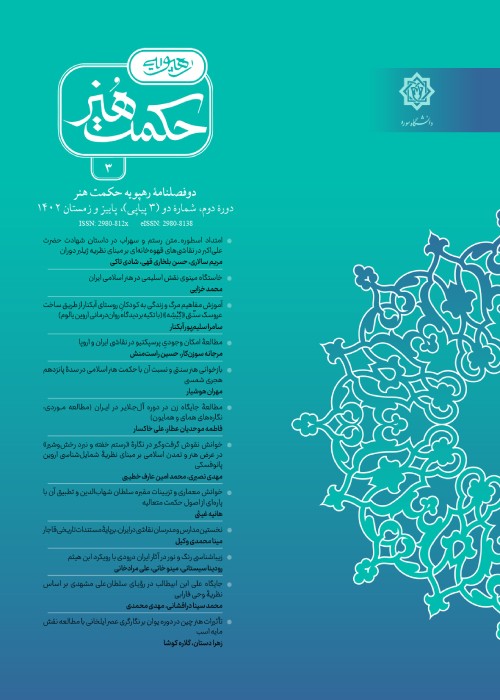Extension of the Myth-Text of Rostam and Sohrab in the Story of Martyrdom of Hazrat Ali Akbar (AS) in Coffee House Paintings Based on Gilbert Durant’s Opinions
Coffee house painting is a style of Iranian folk painting that benefits from two great sources of Iranian culture: Iranian national culture and Iranian Shiite culture. Among the subjects of the coffee house paintings, the two themes of the story of Rostam and Sohrab and the martyrdom of Hazrat Ali Akbar (a.s.) are frequent subjects. However, it seems that the painters have followed a single model and structure with two different worldviews (national and religious themes) in depicting the two events. This research, using the approach of the daily and nightly system of Gilbert Doran and in a descriptive-analytical method, shows how the coffee house artists, referring to the archetypes, symbols, and motivations, have transfigured the character of Hazrat Ali Akbar (a.s.) in the body of Sohrab. These works combine symbols of animal form, darkness, and falling, drawn from everyday imaginings with negative connotations, representing the fear of death and the passage of time. They intertwine these with common archetypes, such as animal imagery or the portrayal of negative traits in animals, like growling, fleeing from restraint, bloodshed, or the hero’s descent from top to bottom, as a symbol of failure and downfall. These are similarly depicted in both themes, to the same extent and in similar compositions—the killing of Sohrab and the martyrdom of Hazrat Ali-Akbar (AS).On the other hand, there are positive symbols related to overcoming time and fear with archetypes such as swords, knives, daggers, or bows that distinguish purity from impurity and also represent the cultivation and purity of the soul. They are prominently present in both groups of images. A giant man with a big body, which is one of the symbols of ascension, and the light and the organs related to light, which are in the category of spectacular symbols, in the body and face of the main subjects, namely Rostam and Imam Hossein (a.s.). can be identified. In short, it should be mentioned that all the negative and positive symbols in both groups of images are depicted with the same elements and archetypes. In all these pictures, Rostam’s father and Imam Hussain (a.s.) are depicted sitting upright, while holding the head of their dying child in their arms. This upright sitting position of the father belongs to the daily system with a positive value and can be classified in the group of ascension symbols. This figure, sitting upright, refers to the stages of ascension and exaltation of the hero. A giant man, a giant, an angel, or symbols related to light and light organs are also other positive archetypes known in the group of positive symbols and the category of ascension and spectacular symbols. In these images, we can identify the imposing figure of the hero, the invincible body of Rostam, and the blessed body with the radiant aura of Imam Hussain (a.s.). In examining paintings depicting the martyrdom of Hazrat Ali Akbar, the notable aspect is the symbolic presence of the sun, not as a passive object but as an active participant in the scene. Ashura happens at noon and when the sun is at the center of the sky. But the sun depicted in the paintings takes on a symbolic and symbolic color and plays the role of an observing subject seeking to uncover the truth. This Sun is a reminder of the ancient God, Mithras, who is the symbol of the seal in the Iranian love religion, and in the Avesta, the body of Ahura Mazda is likened to the sun. In the theoretical system of Doran, the sun is also considered as the eye of God. It is considered as one of the spectacular symbols. In the paintings with the theme of the martyrdom of Hazrat Ali Akbar (a.s.), we can clearly see this adaptation of the content of the Shahnameh, that the sun is not an insignificant object, but an independent personality and as one of the symbols representing the truth. It has a decisive presence in the battle between good and evil and is the eye of God watching over the story. In fact, by taking the help of the element of imagination and using the myth-text of Ferdowsi’s Shahnameh, the Coffee house painters tried to depict personal fears (fear of death) and the collective unconscious (the passage of time) in a Shiite narrative.
- حق عضویت دریافتی صرف حمایت از نشریات عضو و نگهداری، تکمیل و توسعه مگیران میشود.
- پرداخت حق اشتراک و دانلود مقالات اجازه بازنشر آن در سایر رسانههای چاپی و دیجیتال را به کاربر نمیدهد.



